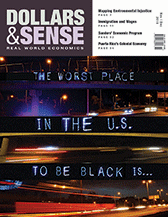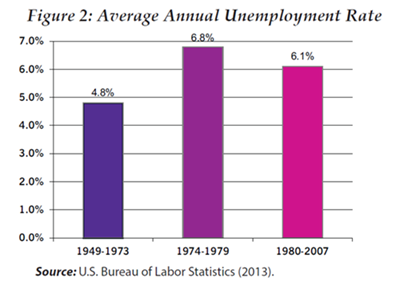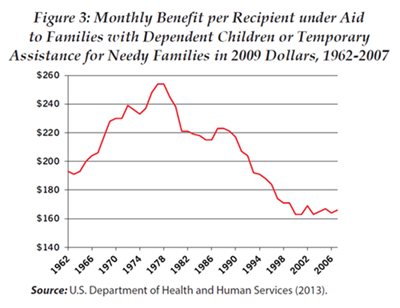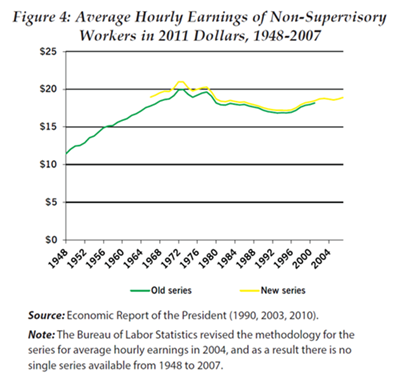A Great Fall: The Origins and Crisis of Neoliberalism
The First Part of a Two-Part Article (click here for Part 2)
This article is from Dollars & Sense: Real World Economics, available at http://www.dollarsandsense.org

This article is from the
November/December 2015 issue.
Subscribe Now
at a 30% discount.
In the fall of 2008, a massive financial and economic crisis struck the United States and much of the world. The biggest American banks were suddenly insolvent and survived only thanks to government bailouts. A deep recession spread around the globe. The unemployment rate in the United States jumped up to 10%. Over the following five years, more than four million U.S. homeowners were tossed out of their homes due to foreclosure, as home values plummeted below the mortgage debt owed and unemployment cut household incomes. The economies of the United States, Europe, and much of the rest of the world have been stuck in stagnation or worse since 2008.
This condition is not something new in the history of capitalism. Capitalist economic systems—in which a small percentage of the population owns the enterprises, hires wage workers, and sells the products aiming for a profit—have brought economic growth but also periodic severe economic crises. To understand these recurring crises, we need to take account of the quite different forms of capitalism over time. While always having the key features noted above, capitalism has nevertheless not looked the same at all times. For several decades following World War II, the United States had a “regulated capitalism” in which government, trade unions, and other non-market institutions played major roles in regulating the economy. Since 1980, we have lived under “neoliberal capitalism,” in which the government retreated from regulation of business and markets, and trade unions were marginalized (see sidebar). In the past, each form of capitalism has worked well on its own terms—fostering investment and economic growth—for a few decades, after which snowballing problems gave rise to severe economic crises such as today’s.
Regulated vs. Neoliberal Capitalism:
How Do They Compare?
The American economy underwent a sea change some 35 years ago, around 1980. The before-vs.-after contrast is striking, whether we look at labor relations, industry regulation, taxes, or corporate management.
- Before: A typical General Motors worker enjoyed a secure full-time job and a paycheck that supported a family of four, although the work was hard, dirty, and dangerous. This was not the case for most U.S. workers, but it does describe conditions for a substantial minority.
After: The typical worker at today’s leading employer, Walmart, has a part-time job, struggling to get by on $8 an hour plus government benefits like food stamps, with no health insurance and no prospects for promotion. - Before: The government closely regulated major parts of the economy. In the financial sector, government agencies set interest rates and restricted the activities of banks and other financial institutions. Government commissions set prices and regulated firms’ behavior in transportation, telephone communications, and electrical power. The aims were guaranteeing economic stability and preventing monopolistic abuses, although in some cases the regulated companies “captured” the regulators.
After: The formerly regulated companies were freed to go wherever their profit motive led them. We saw the results. In 2000, for example, California experienced an energy crisis with an 800% electricity price increase and rolling blackouts, as deregulated power companies had failed to build profit-reducing excess capacity to insure against just such events. Then, in 2008, the deregulated major banks, after years of increasingly speculative and highly profitable activities, all faced failure and were saved by the taxpayers. - Before: In the 1950s, the highest personal (marginal) income tax rate was 91.5%. Despite yowls of protest from the rich and their hired intellectual guns warning that this would kill incentives, investment was robust and the economy grew at record rates for 25 years.
After: In the 1980s, top income tax rates sank to 28% amidst promises of expanding saving and investment, with a rising tide to lift all boats. Instead, saving almost disappeared, investment was lackluster, and the tide lifted the yachts of the 1% while swamping the rafts of much of the remaining 99%. - Before: The CEO of the typical large corporation was a company man (yes, always a man) whose entire career was with that company, fostering a focus on long-run profit through productive investments. The pay was good, averaging 29 times that of the average worker’s pay in 1978.
After: Big corporations increasingly hired their CEOs (still overwhelmingly male) from the outside, in a newly developed market for top executives. As corporations competed for managers with top reputations, CEO pay burgeoned to a remarkable 352 times the pay of the average worker in 2007. CEOs increasingly spent time planning their next job move, implementing measures to boost the company’s stock price in the short-run instead of productive investments that might take years to bear fruit.
The crisis of neoliberal capitalism has made it vulnerable to replacement by something else. Every past economic crisis of this severity has been followed by major changes in economic and political institutions. Earlier so-called “free-market” forms of capitalism have produced economic crises before in U.S. history—in the 1890s and the end of the 1920s. In each case, the crisis was followed by the construction of some kind of regulated capitalism, in response to the forces that had brought on the crisis. After 1900, Progressive Era reforms together with the rise of powerful Wall Street banks led to a corporate-dominated form of regulated capitalism. This lasted until the end of World War I, when another shift brought a decade of relatively unhindered pursuit of profit—the Roaring Twenties—that culminated in the 1929 crash. Eventually, a more thoroughly regulated capitalism, this time based on capital-labor compromise, emerged in the late 1940s. While history does not always repeat itself, there is good reason to expect that, if U.S. capitalism is to surmount the stagnation that has followed the crash of 2008, it will do so through another version of regulated capitalism, which can potentially address the problems that led to the current crisis.
Several big questions cry out for answers. Why did the last sea change, from regulated to neoliberal capitalism, take place—not just in the United States but in much of the world—around 1980? Why did a radically different form of capitalism emerge after decades of active state regulation and strong trade unions? Why did the post-1980 “neoliberal capitalism” eventually produce such a big economic crisis after 25 years of seemingly stable, if lackluster and unequally distributed, economic growth? And most immediately, what kind(s) of economic change are possible and likely today? The relative strength and determination of key economic classes has decided the direction of economic change in past crisis periods, and the current one is not likely to be an exception.
Big Business and the Origins of Regulated Capitalism
The post-World War II “regulated capitalism” emerged in the United States in the late 1940s, following a decade of labor militancy, the formation of strong industrial unions, and militant strikes and factory occupations in the 1930s. After the wartime no-strike pledge ended in 1945, labor militancy resumed. At that point, a decisive section of big business concluded that its long-standing effort to crush unions had failed and decided to strike a deal with the labor movement.
A threatening world pushed big business in that direction. Labor, Social Democratic, Socialist, and Communist parties were in power or contending for power in the UK, France, Italy, and Japan. Even in the United States there was a relatively strong Communist party. A suddenly enlarged and empowered bloc of states—encompassing some 35% of the world’s population—was ruled by Communist parties. Despite the unsavory features of those regimes, which limited their appeal to workers in the West, big business feared that they lent credence to the possibility of a viable alternative to capitalism.
Not least, big business leaders (like many others) feared that, with the end of the huge public spending of World War II, the Great Depression would return. The Committee for Economic Development (CED), the leading big-business policy organization of that period, warned that another big depression might give rise to a “growing receptivity to futile or dangerous ideas that appear to promise relief from all ills”—that is, they feared a growing receptivity to socialism.
CED policy statements endorsed collective bargaining with unions, expansion of Social Security, and a Keynesian program of government spending and tax cuts to fend off another depression and keep the unemployment rate relatively low. Big business formed an informal coalition with organized labor that completed the construction of regulated capitalism, which had begun with the New Deal reforms of the 1930s.
Some analysts refer to a “capital-labor accord” after World War II, but that term suggests a more cordial relationship than the uneasy compromise actually hammered out. Big business leaders held their noses as they agreed to arrangements that legitimized unions and reduced management power in certain ways (employers accepted collective bargaining over wages, benefits, and conditions, contract grievance procedures, and so on). In return, unions accepted “management rights” clauses in collective bargaining agreements—leaving decisions over the production process, technology, product design, pricing, etc. as the employers’ exclusive domain—and accepted responsibility to crack down against worker job actions like slowdowns or wildcat strikes outside of contract-negotiation periods. While this deal did deliver labor relations that were more stable in some ways, it did not eliminate class conflict at the workplace, as major strikes still occurred frequently during the 1950s and 1960s. The capital-labor accord, along with the other features of regulated capitalism, delivered relatively robust economic growth, with rising profits for business alongside increasing wages for workers—what some observers came to call the “Golden Age of Capitalism.”
The Crisis of the Postwar System and the Big Business Response
No form of capitalism, however, works smoothly forever. In the late 1960s, the average rate of profit began to fall in the United States, the UK, and France. In the United States, it declined by more than half from 1966 to 1982 (see Figure 1), a development that big business spokespeople blamed on excessive wage gains. The aim of business is profit, and when profit falls for an extended period of time this tends to destabilize the economy. In the 1970s, the economy became increasingly unstable, with rising inflation and unemployment. The Bretton Woods international monetary system dating back to 1944—with fixed currency exchange rates based on the U.S. dollar—tottered and then collapsed in 1973.
For a decade, big business sought to solve its growing problems within the system of regulated capitalism. However, modest reform efforts failed to resolve the crisis, and by the late 1970s it had changed its position. The main big-business lobbying group of that period, the Business Roundtable, began to blame a strong labor movement for the decline in profits. Big business was also agitated by the victories, in alliance with organized labor, of the environmental, occupational-health, and consumer-product-safety movements, and the resulting expansion of government regulation of industry in the 1970s. Groups like the Business Roundtable grabbed onto neoliberal ideas and policies as the way to resolve the problems facing big business.

As big business deserted its previous coalition with organized labor, and allied with small business organizations that had never supported regulated capitalism, it was able to rapidly sweep away the institutions and dominant ideas of regulated capitalism. While organized labor was relatively strong at that time, it could not stop a determined push by a united business class to carry out economic restructuring at the expense of labor and the majority of the population. By the early 1980s, a new form of capitalism had emerged—the neoliberal capitalism that we still live under to the present day.
The end of regulated capitalism and the rise of neoliberalism brought with it a new orthodoxy in economics. Gone were the days when professors at America’s leading universities taught that capitalist economies required close regulation by the government to avoid big depressions and high unemployment, and that trade unions played a positive role in reducing inequality. In its place arose a new worship of “free markets,” rejecting any role for government or trade unions in improving economic outcomes.

Starting in the early 1980s the declining profit rate reversed and trended upward thereafter (see Figure 1). The neoliberal mantra of privatization, liberalization, and deregulation, as put into practice, served to crush organized labor and put employers in control. Liberalizing foreign trade and removing barriers to capital flight put American workers in more direct competition with low-wage labor in poor countries. Stopping Keynesian policies aimed at a low unemployment rate gave rise to a higher unemployment rate after 1980 than from the late 1940s to early 1970s (see Figure 2).
This weakened labor’s bargaining power. Privatizing and cutting back social welfare programs, too, weakened workers’ fallback position in bargaining with employers (see Figure 3).
Lax enforcement of labor law facilitated the corporate agenda of driving out unions and extracting huge wage concessions. Deregulation of basic industries resulted in cutthroat competition replacing the stable environment of government regulation—and relatively high-wage jobs won by unions gave way to rapidly declining pay and worsening working conditions.

Big business could not have effectively argued that wages must fall so that profits could rise, that welfare recipients were too rich while CEOs were too poor, that the unemployment rate should be driven up so that wages could be driven down, or that American workers should be forced into a “race to the bottom” with the poorest workers in the world. However, neoliberal restructuring of American and global capitalism achieved all those aims by promising great economic benefits for all citizens once the magic of the “free market” was unleashed.
Economic Foundations of Neoliberal Capitalism
For some 25 years, neoliberal capitalism in the United States produced long, if tepid, economic expansions with low inflation. Former Federal Reserve Chairman Ben Bernanke coined the term “The Great Moderation” to describe what neoliberal economists believed was a newly stabilized capitalism, a result of lifting the heavy hand of government from the back of big business, and the “grasping” hand of unions from its pockets. While the rich got richer at an astonishing and accelerating rate, the majority did not fare well. As long as neoliberal capitalism was delivering rising profits and growing riches for those at the top, however, it was difficult for critics to make much headway against it.
Beneath the surface, though, long-run trends guaranteed an unhappy ending down the road. Neoliberal capitalism brought three key developments that led to the crash of 2008.

The first was rapidly growing inequality. As neoliberal restructuring undermined labor’s bargaining power, real wages stagnated (see Figure 4). This allowed profits to recover from their long decline. The big gap emerging, after 1979, between profit growth and wage and salary growth jumped sharply upward after 2000 (see Figure 5).
The second key development was the transformation of financial institutions and their role in the economy. Bank deregulation began in 1980-1982, and soon financial institutions began to create a raft of so-called “financial innovations”—new types of financial assets such as subprime mortgage-backed securities, collateralized debt obligations, and credit default swaps. The high profitability of such maneuvers pushed the profits of the financial sector from about 20% of all corporate profit to a remarkable 40% in the early 2000s. The term “financialization” arose to describe the expanding and changing role of the financial sector in contemporary capitalism.

The third development was a series of large asset bubbles—that is, the continuing rise in the prices of assets like real estate or corporate stocks, driven by speculative expectations of further price increases. The 1980s saw a bubble in southwestern commercial real estate, whose collapse sank a large part of the savings-and-loan industry. In the second half of the 1990s, a giant stock market bubble arose. And in the 2000s, a still larger bubble engulfed the U.S. real estate market. The preceding period of regulated capitalism had no large asset bubbles. The rapidly rising flow of income into corporate profit and rich households exceeded the available productive investment opportunities, and some of that flow found its way into investment in assets. The eagerness of the deregulated financial institutions to lend for speculative purposes enabled incipient asset bubbles to grow larger and larger.
Neoliberal Capitalism and the Crisis of 2008
Growing inequality, the speculative financial sector, and the series of large asset bubbles all contributed to the long economic expansions in the U.S. economy during the neoliberal era—1982–1990, 1991–2000, and 2001–2007.
These trends, however, were unsustainable in the long run. From 1980 to 2007, household debt doubled relative to household income. Financial institutions, finding limitless profit opportunities in the wild financial markets of the period, borrowed heavily to pursue those opportunities. As a result, financial-sector debt increased from 21% of GDP in 1980 to 117% of GDP in 2007. At the same time, financial institutions’ holdings of the new high-risk securities grew rapidly. In addition, unused resources in the industrial sector gradually crept upward over the period from 1979 to 2007, as consumer demand increasingly lagged behind the total productive capacity of the economy.
As long as a big asset bubble continued to inflate, people remained willing to borrow more and more, and financial institutions remained willing to lend to them. But every asset bubble eventually must burst. When the biggest one—the real estate bubble—started to deflate in 2007, the crash followed. As households lost the ability to borrow against their no-longer-inflating home values, consumer spending dropped at the beginning 2008, driving the economy into recession. Falling consumer demand meant more excess productive capacity, leading business to reduce its investment in plant and equipment. The deflating housing bubble also worsened investor expectations, further depressing investment. Finally, in the fall of 2008, the plummeting market values of the new-fangled financial securities, which had been dependent on real-estate prices, suddenly drove the highly indebted major commercial banks and investment banks into insolvency, bringing a financial meltdown.
Thus, the big financial and broader economic crisis that began in 2008 is explained by the way neoliberal capitalism worked. The very same mechanisms that brought 25 years of long expansions under neoliberal capitalism were bound to eventually give rise to this sort of “big bang” crisis.
Did you find this article useful? Please consider supporting our work by donating or subscribing.
